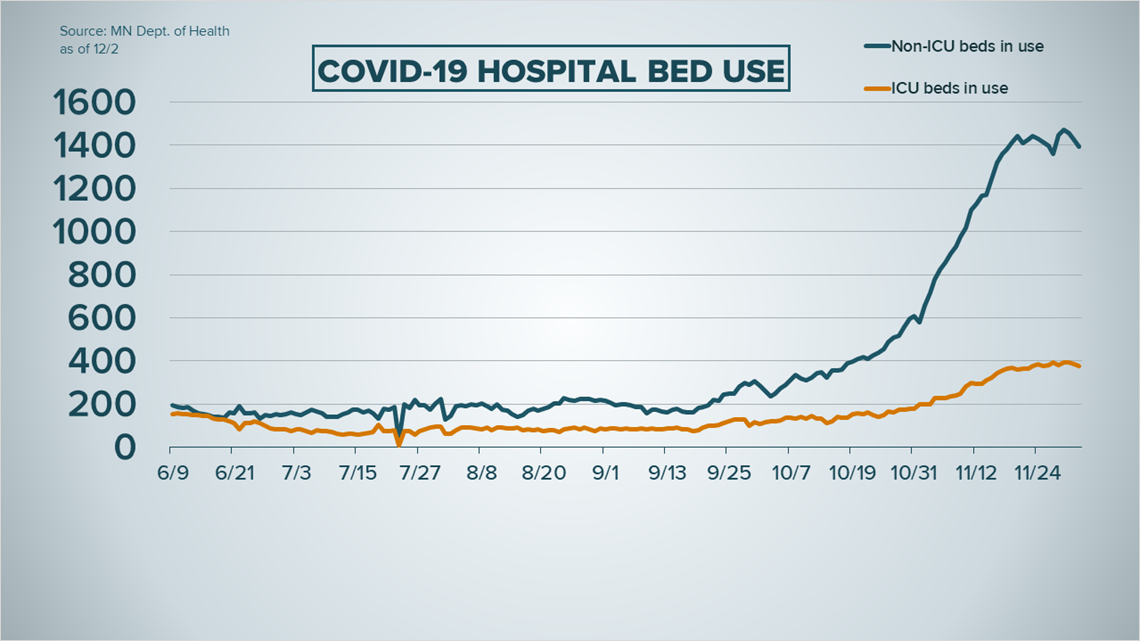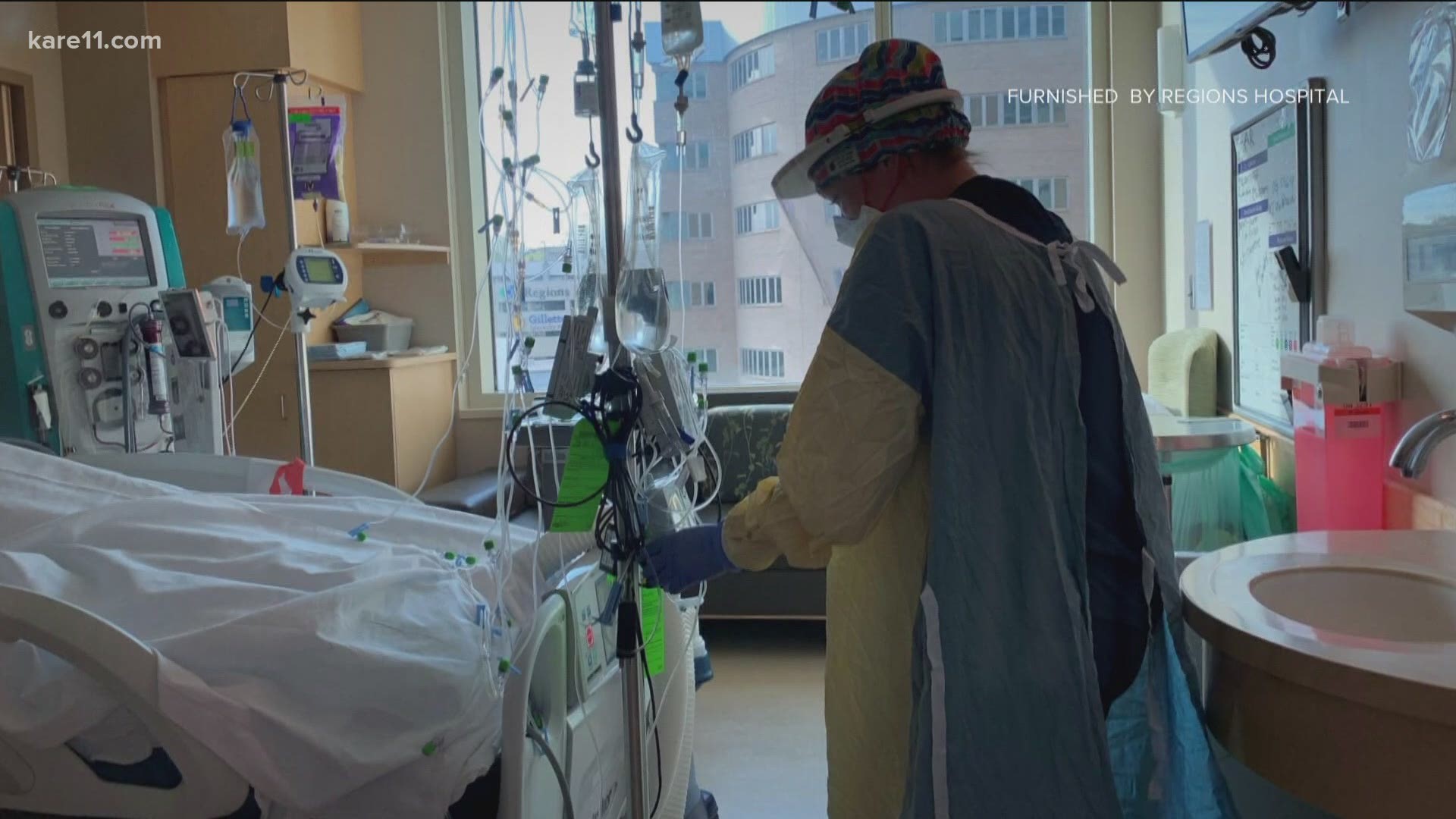ST PAUL, Minn. — Thursday, Dec. 3
- MDH reports 92 COVID deaths, second-highest daily count
- Minnesotans have until Dec. 7 to request housing assistance
- MSHSL sets tentative schedule for winter sports
- Hospital bed use down across Minnesota
- Officials say we are at the endgame of the pandemic with upcoming vaccines
4 p.m.
The New York Times has unveiled a new online tool that can help people estimate when they might be able to receive a COVID-19 vaccine. That tool can be found here on the Times website.
1 p.m.
Gov. Tim Walz and Lt. Gov. Peggy Flanagan are urging Minnesotans to draw upon state aid for their end-of-year housing bills.
In a media call at 1 p.m. Gov. Walz highlighted efforts to "ensure Minnesotans can afford to stay in their homes during the COVID-19 pandemic."
Minnesotans can apply for housing assistance through the United Way by calling 211 or going online at 211unitedway.org. The deadline is Monday. Dec. 7 at 11:59 p.m. As of the end of November, the state still had over $30 million available to give out to those struggling to make housing payments.
11 a.m.
COVID-19 is continuing to take a significant number of lives in Minnesota, with 92 new fatalities reported by state health officials on Thursday
Those deaths are the second highest single-day total since the pandemic began, only behind the 101 deaths reported the Friday after Thanksgiving. The total number of lives lost in the state now sits at 3,784. Thursday's near-record comes just one day after the third-highest daily death toll of 77.
The Minnesota Department of Health (MDH) says 6,166 new coronavirus cases were reported Thursday, based on results from 50,718 tests (45,885 PCR, 4,833 antigen) processed in private and state labs.
A positive PCR test is considered a confirmed case, while a positive antigen test is considered probable.
Minnesota now reports 333,626 COVID-19 cases since the start of the pandemic.
Hospitalizations due to the coronavirus in Minnesota are continuing a downward trend. COVID-19 patients are currently using 1,394 non-ICU beds across the state - 29 fewer than the day prior, and 376 ICU beds - nine fewer than the previous day. Metro bed availability has improved from 1.9% to 2.3%, and ICU bed availability in the metro has grown from 4.5% to 5.7%.
The total number of patients hospitalized since COVID hit Minnesota is 17,623, with 3,911 of those requiring treatment in the ICU.


COVID-19 case rates now put 86 of 87 Minnesota counties under full distance learning recommendations from MDH, although community spread is only one factor of many schools are instructed to use to determine their learning model.
Leading causes of exposure for those who have tested positive include community exposure with no known contact (62,312 cases) followed by a known contact (55,953 cases) and exposure through a congregate care setting (26,100 cases).
Young people 20 to 24 make up the largest group of cases with 35,289 and two deaths, followed by those 25 to 29 with 30,360 and four deaths. The greatest number of fatalities involves people 85 to 89 with 712 in 4,244 confirmed cases.
Hennepin County has the most recorded COVID activity with 70,069 cases and 1,145 deaths, followed by Ramsey County with 29,459 cases and 521 deaths, Dakota County with 23,564 cases and 198 deaths and Anoka County with 23,541 cases and 236 fatalities.
Cook County in northeastern Minnesota has the least amount of COVID activity with 80 cases and no deaths.
Wednesday, Dec. 2
2 p.m.
On Wednesday, Governor Tim Walz, Department of Public Safety Commissioner John Harrington and several first responders spoke to Minnesotans to address the way the COVID-19 pandemic has impacted public safety and emergency response.
Walz said that he hopes to highlight aspects of everyday life that are impacted by the pandemic that many Minnesotans may not typically consider. According to Walz, the workforce of firefighters, police officers and paramedics in Minnesota has been affected by COVID-19, which can impact their ability to respond to emergencies.
Harrington emphasized that this is a statewide issue, and that he is hearing every day from fire departments and police departments that are having staffing issues due to COVID-19.
He added that fire departments have been hit particularly hard.
"Ninety-nine out of the 500 fire departments in the state of Minnesota have had major COVID outbreaks," he said. "That's 20%."
He stressed that the state has worked to rearrange resources and take precautions to keep departments staffed, but it won't take much to take those departments out of service if communities do not wear masks, avoid gatherings and social distance.
Eagan Police Chief Roger New said that his department has followed CDC guidelines since the pandemic began, but he has still seen 20% of his staff take time off due to COVID-19 quarantines at some point since March, including one staff member who was hospitalized and took two months to fully recover.
Jay Wood, a firefighter in Plato, said that the Plato Fire Department has also carefully followed guidelines, but an outbreak that affected over three quarters of the department forced them to take the department out of service for a time.
"We are not alone as a small department of dealing with the virus and the staffing issues it has presented to us," he said. "Minnesota fire services are always here to help the public, and people always ask how they can help us. The biggest thing you can do is follow the guidelines the governor and the Department of Health have set for us."
Paramedic Ross Chavez echoed this, urging Minnesotans to follow advice from health experts to help keep first responders in the community healthy so they can continue providing fast and effective emergency services.
"Please, help my colleagues and me be there for those who need us, especially this holiday season during these trying times," Chavez said.
Walz said that for Minnesotans frustrated by other community members not following these guidelines, he does not want to shame anyone, but it is a "moral hazard" to not wear a mask and go to large gatherings.
"We're not going to be able to arrest everybody, that was certainly never our intention," he said. "You don't have to follow these rules because I said so, you don't have to follow them because you don't like government. You should follow them because they're the right thing to do, they protect lives."
Walz added that by next Tuesday, he hopes he and state health officials will have a clear timeline for a COVID-19 vaccine in the U.S. Minnesota Department of Health (MDH) Commissioner Jan Malcolm said she expects the FDA will issue an emergency use authorization on Dec. 11, and that the first wave of vaccinations could begin as soon as a week or so later.
Walz said he understands concerns around safety of the vaccine, but his assessment has been that the federal government has done a "fantastic job" of the vaccine development.
However, he stressed that though the excitement around the vaccine may indicate that the pandemic is over, we are still "in the teeth of it."
"Let's make sure we get all of our neighbors there, and protect those folks that make a difference," he said.
11 a.m.
The resurgence of COVID-19 in Minnesota is proving deadly, as underscored by 77 new fatalities reported by state health officials Wednesday.
Those deaths are the second highest single-day total since the pandemic came to Minnesota, only behind the 101 deaths reported the Friday after Thanksgiving. The total number of lives lost in the state now sits at 3,692.
The Minnesota Department of Health (MDH) says 5,192 new coronavirus cases were reported Wednesday, based on results from 42,737 tests (39,912 PCR, 2,825 Antigen) processed in private and state labs.
A positive PCR test is considered a confirmed case, while a positive Antigen test is considered probable.
Minnesota now reports 327,477 COVID-19 cases since the start of the pandemic.
In a bit of positive news, hospital bed use is down after a surge in recent days. Coronavirus patients are currently using 1,350 non-ICU beds, down 104 from Tuesday, and 354 ICU beds across the state are being used for COVID patients, down 40 from a day ago.
The total number of patients hospitalized since COVID hit Minnesota is 17,378, with 3,873 of those requiring treatment in the ICU.
Leading causes of exposure for those who have tested positive include community exposure with no known contact (60,808 cases) followed by a known contact (54,554 cases) and exposure through a congregate care setting (25,695 cases).
Young people 20 to 24 make up the largest group of cases by a significant margin with 34,806 and two deaths, followed by those 25 to 29 with 29,876 and four deaths. The greatest number of fatalities involves people 85 to 89 with 691 in 4,156 confirmed cases.
Hennepin County has the most recorded COVID activity with 68,898 cases and 1,130 deaths, followed by Ramsey County with 28,948 cases and 512 deaths, Anoka County with 23,196 cases and 232 fatalities, and Dakota County with 23,102 cases and 194 deaths.
Cook County in northeastern Minnesota has the least amount of COVID activity with 79 cases and no deaths.

